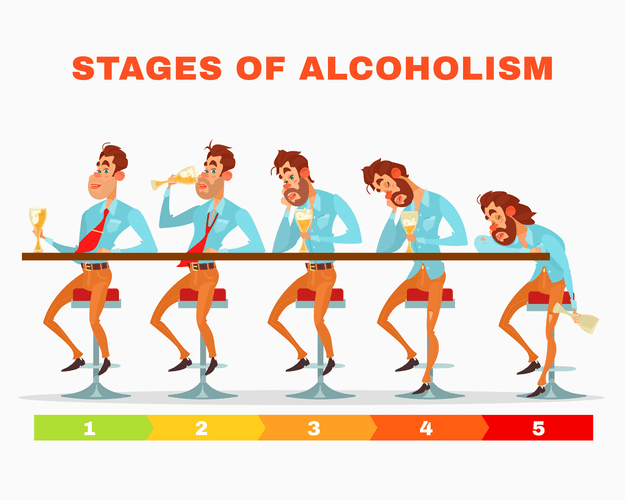Content
Alcoholism is often called a family disease because it hurts the lives of family members and others who are close to the alcoholic. For the alcoholic to get well, family members often must take part in treatment. It can be hard for doctors to decide which patients to monitor for alcoholism as some signs and symptoms could be due to other illnesses. These is an increasing awareness that long-term alcohol use is connected to brain degenerative disorders such as dementia and Alzheimer’s. These problems as a result of chronic alcohol use include gastritis, which is damage to the stomach lining. The cravings to consume alcohol can be as strong as a need like hunger.
It’s really hard not to feel the ever growing surge of cutesy, women aimed merch glorifying being drunk any time of day (signs, shirts, & accessories with “but first, WINE!” or the giant glass etched with “Mommy Juice”) is just normalizing alcoholism in women.
— T (@torboni) December 3, 2021
Learn how to recognize the warning signs and symptoms. If a blood test reveals that the red woman addicted to drinking paint blood cells have increased in size, it could be an indication of long-term alcohol abuse.
Related Health Topics
Tolerance means that, over time, you need more and more alcohol to feel the same effects. Often, family members and close friends feel obligated to cover for the person with the drinking problem. So they take on the burden of cleaning up your messes, lying for you, or working more to make ends meet. Pretending that nothing is wrong and hiding away all of their fears and resentments can take an enormous toll. Children are especially sensitive and can suffer long-lasting emotional trauma when a parent or caretaker is an alcoholic or heavy drinker. But even if you’re able to succeed at work or hold your marriage together, you can’t escape the effects that alcoholism and alcohol abuse have on your personal relationships. Drinking problems put an enormous strain on the people closest to you.

Having friends or a close partner who drinks regularly could increase your risk of alcohol use disorder. The glamorous way that drinking is sometimes portrayed in the media also may send the message that it’s OK to drink too much. For young people, the influence of parents, peers and other role models can impact risk.
Progressive Symptoms
There are inpatient and outpatient options, but an addiction specialist should determine the best level of care for you based on your individual needs. One of the early signs is a pattern of excessive drinking. This pattern includes both binge drinking and heavy drinking. Binge drinking is when someone drinks a large amount at one time. For men, it’s drinking five or more drinks within two hours. For women, it is having four or more drinks within two hours.
It’s really hard not to feel the ever growing surge of cutesy, women aimed merch glorifying being drunk any time of day (signs, shirts, & accessories with “but first, WINE!” or the giant glass etched with “Mommy Juice”) is just normalizing alcoholism in women.
— T (@torboni) December 3, 2021
These women may also be at a higher risk for amenorrhea. This is a condition where one does not get a period of 3 months or more. This phenomenon causes ovulation to occur out of sync with one’s menstrual cycle. Alcohol abuse can have many other effects on one’s menstrual cycle. We mentioned some of the criteria for an alcohol use disorder above.
Find A Womens Alcohol Recovery Program
About 50% of people who drink in this group have alcohol use disorder. Alcohol may interfere with the production of new bone. This bone loss can lead to thinning bones and an increased risk of fractures. Alcohol can also damage bone marrow, which makes blood cells. This can cause a low platelet count, which may result in bruising and bleeding. Excessive drinking can lead to high blood pressure and increases your risk of an enlarged heart, heart failure or stroke.
Both of these might indicate chronic alcohol consumption. Blood tests can only reveal very recent alcohol consumption. They cannot tell whether a person has been drinking heavily for a long time. Some signs and symptoms of alcohol abuse may be due to another condition. Ageing can lead to memory problems and falls, for example. In the past, a person with this condition was referred to as an “alcoholic.” However, this is increasingly seen as an unhelpful and negative label. Health professionals now say that a person has an alcohol use disorder .
Other Signs And Symptoms Of Alcoholism
If a health worker suspect alcohol may be a problem, they may ask a series of questions. If the patient answers in a certain way, the doctor may then use a standardized questionnaire to find out more. The criteria include having a pattern of consumption that leads to considerable impairment or distress. According to the World Health Organization , globally, 3.3 million deaths every year result from the harmful use of alcohol.

Treatment programs and online alcohol rehab are available if you are facing an alcohol problem. Alcoholism may take many forms, and stereotypes don’t always hold true. Find out how to tell the difference between casual use, alcohol abuse and addiction. Jeffrey Juergens earned his Bachelor’s and Juris Doctor from the University of Florida. Jeffrey’s desire to help others led him to focus on economic and social development and policy making.
When Your Teen Has A Drinking Problem
A woman with a DUI may have difficulties finding employment. Her auto insurance rates may also skyrocket, as she is seen as a liability on the road. She may even get her driver’s license revoked or suspended depending on the severity of her charge. In either their childhood or adulthood are more likely to develop an alcohol problem to numb the pain.
- Carbohydrate-deficient transferrin is a blood test that helps detect heavy alcohol consumption.
- Symptoms of dependence include becoming tolerant to some ofalcohol’s effects and experiencing withdrawal symptoms when alcohol is not consumed.
- However, when an equivalent dose is administered orally, the resulting BAC is higher in women.18,21 This suggests that first-pass metabolism is smaller in females.
- Heavy drinking in conjunction with other behaviors can also signal a problem.
- It may lead to liver diseases, such as fatty liver disease and cirrhosis.
Many people can drink alcohol and not become addicted. Some binge drinkers or party drinkers will not progress beyond the experimental phase to drink regularly. Those who do continue to drink heavily or regularly may do so because they are environmentally or genetically predisposed to do so. For instance, children of people with an alcohol use disorder are four times more likely to also experience this disorder. Most often, these experimenting individuals are either high school students or young adults, such as college students. Drinking is usually a social event among this younger set, and they collectively binge drink as a way of partying. They may not be regular drinkers, but binge drinking alone still puts them at risk of developing alcohol use disorder.
Prevention And Risk Factors
Environmental and genetic factors aside, the sheer number of drinks people consume in a given period of time can put them at risk for developing an alcohol use disorder. Women who have a daily intake of more than three drinks, or more than seven per week, are considered at risk. Men, due to their physiological differences from women, are considered to be at risk if they partake in more than four drinks a day or more than 14 per week. In terms of the DSM-5, new alcohol users could display 0-2 of the 11 symptoms discussed. The difficulty is that one never knows if social or occasional drinking will lead to the development of alcohol use disorder. In the early phases of alcohol abuse, a person will usually get an introduction to different types of alcohol and experiment with alcohol in various forms. The term “alcoholism” is commonly used in American society, but it is a nonclinical descriptor.
We deliver whole-person, comprehensive care and are passionate about transforming the quality, delivery, and accessibility of alcohol addiction & mental health treatment. Our actions are rooted in respect for each member’s values, culture, and life experiences, and our commitment to their wellbeing is unwavering and without judgement. If left untreated, alcohol abuse can spiral out of Alcoholism in family systems control quickly. When alcohol abuse begins to negatively impact a person’s life and causes harm, it is diagnosed as alcohol use disorder . Recognizing the warning signsof alcohol abuse and getting proper treatment can make a significant difference in someone’s recovery process. In addition to the physical signs of alcoholism, it’s also important to be aware of behavioral symptoms.
If you or your loved one needs help with alcohol addiction, contact us today. Throughout history, alcohol has played a significant role in different cultures around the world. Alcohol is used by people as a way to relax, bond, celebrate, and socialize.

With normal stimuli such as food, the brain eventually stops releasing the hormone. As a result, you will no longer feel the same level of satisfaction. On the other hand, alcohol continues to trigger its release despite repeated consumption. The brain then gets used to the presence of dopamine and seeks it out, hence the cravings. A person addicted to alcohol might not see friends or family members as often. The information on this site should not be used as a substitute for professional medical care or advice. Contact a health care provider if you have questions about your health.

